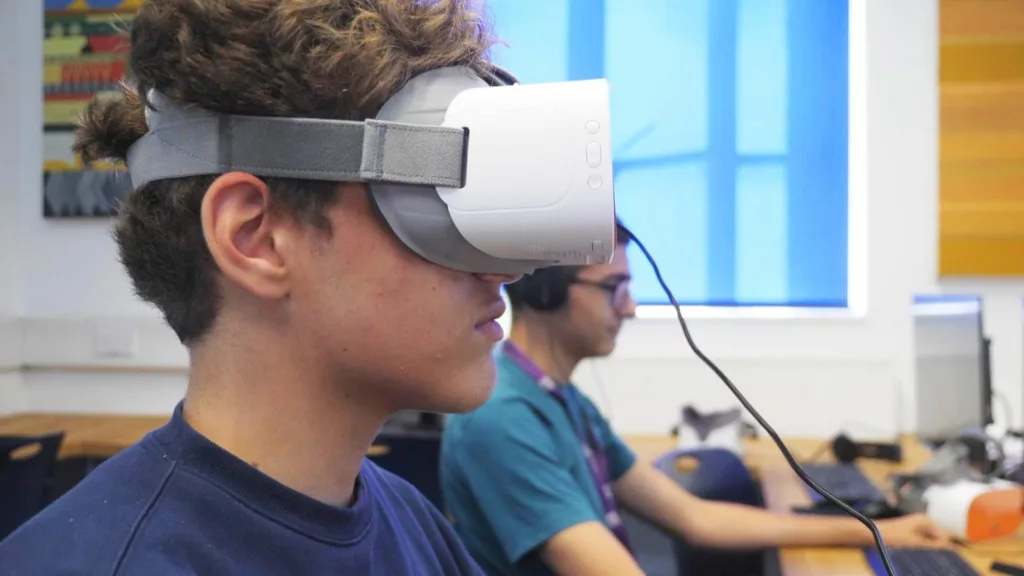AI in ELT: Crossing the Ethical and Technological Frontiers of Language Education

GUEST POST BY ANDY LUCCHESI
Andy Lucchesi is a Generative AI Education Specialist & Business English Teacher who helps students, educators, and academic institutions understand how to use GenAI tools ethically.
The landscape of English Language Teaching (ELT) is experiencing an unprecedented transformation. Artificial intelligence (AI) is emerging not just as a supplementary tool but as a core driver in the way language education is approached across the world. As this technological wave sweeps through educational institutions, language academies, and classrooms, it’s clear that AI is poised to redefine how we teach and learn languages. But with innovation comes critical questions—about ethics, effectiveness, and the very essence of human learning.
But how do we navigate this rapidly evolving frontier without losing sight of the human elements that make language learning so impactful? And just how far should we trust AI to guide students?
Table of Contents
- The AI Revolution in Language Education: More Than Just Tools
- AI and the “Teacherless” Classroom
- Ethical Imperatives in AI-Enhanced ELT
- Balancing AI and Human Expertise in Language Learning
- AI and the Future of ELT: What Lies Ahead?
- Navigating the Ethical Landscape: Critical Questions for the Future
- Conclusion: Embracing the Future of AI in ELT
The AI Revolution in Language Education: More Than Just Tools
Artificial Intelligence (AI) was initially designed to replicate human intelligence, aiming to perform tasks like learning, problem-solving, and understanding language—essentially mimicking human cognitive abilities. But AI’s purpose extends far beyond just copying human thought. It’s about enhancing our lives by automating complex tasks, analyzing vast data, and offering insights that boost efficiency and decision-making, augmenting human capabilities in ways once thought impossible.
In the context of ELT, AI technologies offer an array of benefits—most notably, AI-powered adaptive learning platforms. These platforms analyze data from each student’s performance, allowing for personalized learning paths that can adjust in real time. In a traditional classroom, educators often struggle to cater to each student’s individual pace. With AI, schools, universities, language schools and academies can offer a highly customized experience, helping students progress based on their unique strengths and weaknesses.
AI and the “Teacherless” Classroom
But AI’s impact goes beyond mere personalization. Tools that analyze pronunciation and speaking skills with remarkable precision are now at the disposal of educators and students. These systems evaluate intonation, fluency, and conversational flow, offering detailed feedback in ways that were once limited to in-person teacher interactions. It’s a shift that opens new possibilities for language schools and other education centers expand their teaching methods, reaching more students in more ways than ever before.
One standout example is the Sabrewing programme at David Game College in London, which has launched the UK’s first AI-driven, teacherless classrooms. The Sabrewing programme utilizes AI to entirely replace traditional teaching methods, offering an individualized learning experience that allows students to progress at their own pace. This model speaks to the potential for AI to revolutionize ELT, catering to students who may struggle in conventional classroom settings.
While the Sabrewing programme brings a bold vision of AI in education, it also raises significant questions:
- Can AI fully replace human teachers?
- How will students, especially those who thrive on interpersonal interactions, adapt to a learning environment driven by algorithms?
Ethical Imperatives in AI-Enhanced ELT
As exciting as these advancements are, the introduction of AI into ELT isn’t just about better learning outcomes; it’s about understanding the ramifications of AI’s role in education, particularly regarding data privacy, algorithmic bias, and the balance between human and machine-driven instruction.
One of the most pressing concerns is data privacy. AI-driven platforms rely on vast amounts of student data to function. These platforms monitor everything from a student’s pronunciation patterns to their comprehension speed. Language schools and ELT professionals must ensure that this data is handled ethically, with robust policies that prioritize student privacy. Transparency about how data is collected, stored, and used is essential in building trust between students, parents, and institutions.
In addition, algorithmic bias poses a serious threat to equitable learning. AI systems, by nature, are shaped by the data they are fed. For example, a system primarily trained on American English might fail to accommodate different dialects or language nuances, putting students from diverse linguistic backgrounds at a disadvantage. ELT professionals need to critically evaluate these systems, ensuring that the AI tools they adopt are inclusive and adaptable across various language variants and cultural contexts.
As language schools continue to integrate AI, a key consideration must also be the human element of teaching. AI’s efficiency in delivering personalized education is impressive, but it cannot replicate the social, emotional, and cultural connections that human educators bring to the classroom.
Andy lucchesi
For younger students, in particular, the importance of teacher-student interaction goes beyond academic learning; it’s about developing communication skills, empathy, and emotional intelligence.
In a field like ELT, where culture and context play a vital role, human teachers provide irreplaceable guidance that AI alone cannot deliver.
Balancing AI and Human Expertise in Language Learning
The real question for the ELT force and other sectors of education is not whether AI should replace human educators but how the two can work together. When thoughtfully implemented, AI can free up educators’ time, allowing them to focus on more complex, nuanced aspects of teaching—like fostering creativity, critical thinking, and emotional intelligence. AI’s role, then, is to supplement and support, rather than supplant, the expertise of human teachers.
A compelling example of this approach- since it´s the first of its kind, as previously mentioned – can be found in David Game College’s use of learning coaches in their Sabrewing programme. While AI handles the bulk of the academic instruction, human coaches are still present to oversee students’ motivation, progress, and well-being. These coaches are carefully selected through a rigorous recruitment process, ensuring that they can provide the human support AI cannot. This hybrid model demonstrates how AI and human teachers can complement each other, offering a more rounded learning experience.

AI and the Future of ELT: What Lies Ahead?
As AI continues to evolve, so too will its applications in ELT. Beyond the classroom, AI-powered communication tools are already transforming how language schools engage with students, offering personalized feedback and support outside of scheduled lessons. AI-driven systems can handle administrative tasks, freeing up valuable time for educators to focus on teaching.
Looking to the future, immersive technologies like AI-powered virtual reality (VR) environments could redefine how students experience language learning. Imagine a high school student being able to virtually step into the Louvre, in Paris for a history class or a Business English student attending a meeting in Tokyo to refine their negotiation skills within the local culture. The possibilities are endless, and these emerging trends in education are likely to shape the future of ELT in ways we can only begin to imagine.
But with every leap forward, language schools and ELT professionals must remain vigilant about the ethical implications of AI advancements. As AI increasingly shapes education, the responsibility to uphold ethical standards becomes even more crucial. This includes addressing issues of accessibility, ensuring that AI-driven educational tools are available to all students, regardless of their socioeconomic background, and continuously evaluating the impact of AI on the quality of learning outcomes.
In a ground-breaking move toward global AI governance, the Council of Europe recently opened the first-ever global treaty on AI for signature, marking a significant step in regulating AI development and usage. As reported, the treaty aims to set global standards on human rights, democracy, and the rule of law in AI development, ensuring that these technologies serve the greater good. This international effort underscores the importance of integrating ethical frameworks into AI applications, especially in fields like education, where the stakes are high for students, teachers, and institutions alike.
Navigating the Ethical Landscape: Critical Questions for the Future
As AI’s role in ELT expands, several vital questions emerge:
- How do we ensure that AI enhances rather than replaces the critical human elements of teaching, such as empathy, cultural understanding, and spontaneous interaction?
- Can AI truly bridge the gap between personalized learning and the need for social and emotional development, particularly for younger learners who thrive on human connection?
- What safeguards can language schools put in place to protect student data and ensure AI is used responsibly, especially in light of international regulations like the Council of Europe’s treaty?
As we ponder these questions, it becomes clear that the future of ELT will require a careful, measured approach to AI integration. Educational professionals, language academies, and AI developers must collaborate to ensure that AI tools are both effective and ethical. The Council of Europe’s treaty sets a timely precedent, reminding us that technology must be used not just to advance learning, but to enhance human dignity and protect the integrity of education.
Technology must be used not just to advance learning, but to enhance human dignity and protect the integrity of education.
Andy lucchesi
Conclusion: Embracing the Future of AI in ELT
The future of language education is unfolding before us, driven by the rapid advancements in AI technology. As these education trends continue to evolve, the challenge for language schools, ELT professionals, and educators in general will be to strike the right balance between embracing the efficiencies of AI and preserving the deeply human aspects of language learning.
By approaching AI with curiosity, caution, and a commitment to ethical standards, the ELT field can harness the transformative power of technology without losing sight of its core mission: helping students develop not just language proficiency, but the social and emotional skills that make language learning a truly human endeavour. The path forward lies in a thoughtful integration of AI, one that enhances our capabilities while respecting the intrinsic value of human connection.
Andy Lucchesi
Andy Lucchesi can be contacted by DM on Andy’s Everyday English page on Instagram or LinkedIn
This article is from Gina Rodriguez’s blog.
Gina Rodriguez is an ELT Marketing consultant and founder of GR School Marketing. She supports language professionals and institutions in building an engaging social media presence for attracting students and seizing growth opportunities a.k.a enrolments!
With 25+ years in ELT, she envisions an industry where every language education brand operates with a business mindset. Her services foster continuous improvement and innovation, enabling professionals and schools to showcase their offerings effectively online.
To find out more about GR School Marketing services book a discovery call or email Gina at hello@grschoolmarketing.com



